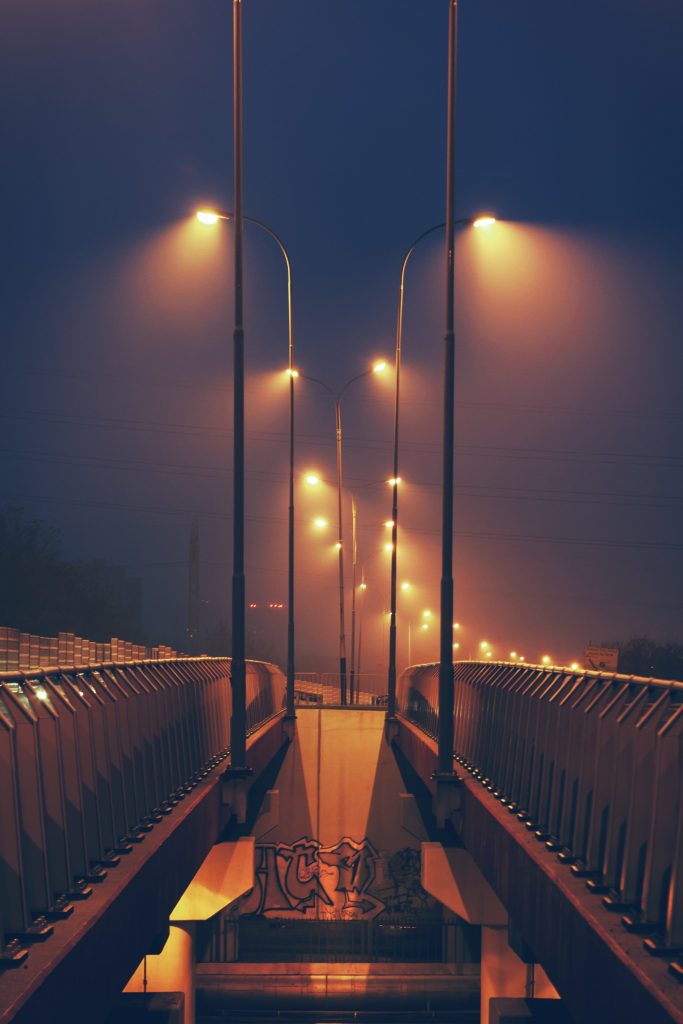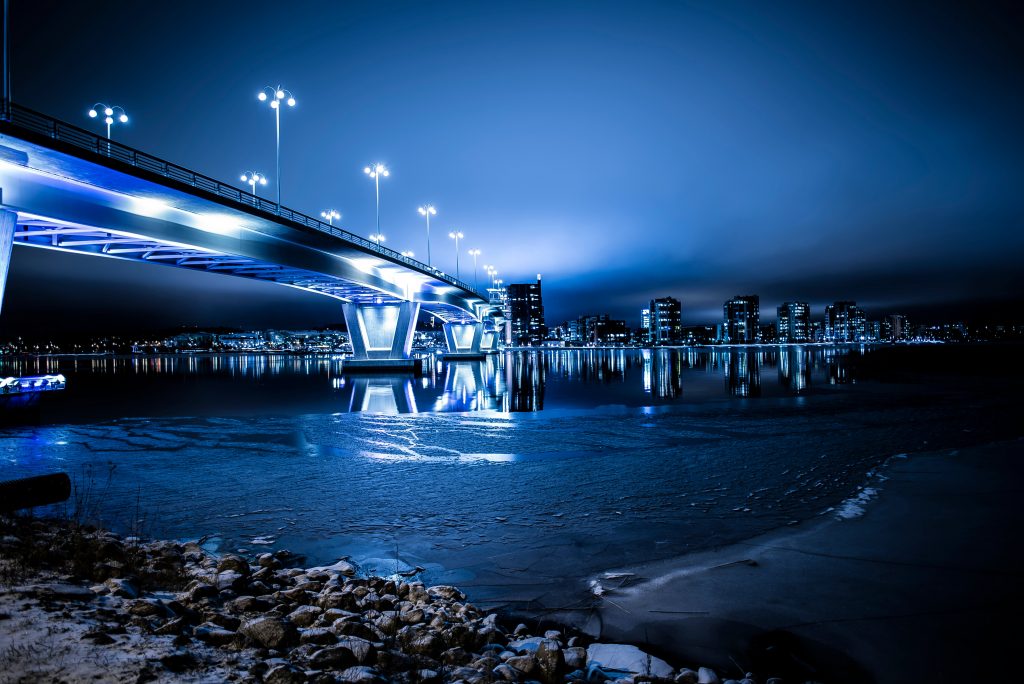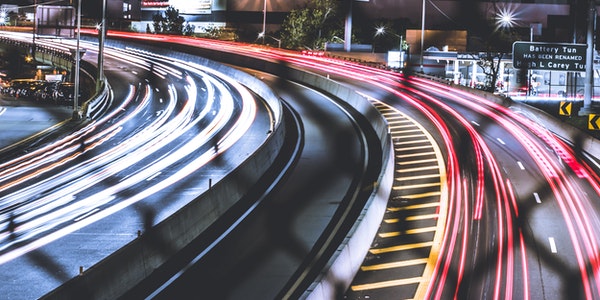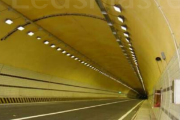Street lighting belongs to public lighting and is controlled by the government. Because LED has the characteristics of high efficiency, environmental protection, energy saving and long lifespan, LED light source can be the first to be applied in street and tunnel lighting.
Lamps used for road lighting are called street lamps. Road lighting fixtures that use LEDs as light sources are called LED street lights. The core of LED street lights is LED light source. The LED street light source is made up of many high-power white LEDs connected through a hybrid connection. In addition to LED modules, LED street lights also include drive power, optical components, and heat dissipation devices.
The development Status of Road Lighting
When people have the need to travel at night, road lighting appears. Modern road lighting began with the appearance of incandescent lamps. Road lighting is developed with the development of the times, the progress of science and technology and the continuous improvement of people’s living standards. From the situation where people only need to illuminate the pavement to perceive the road, to help people identify whether the road is a pedestrian or an obstacle, to help motorized and non-motorized vehicle drivers identify the
characteristics of pedestrians.
The fundamental purpose of road lighting is to provide drivers and pedestrians with good visual conditions and guide them to move in order to improve traffic efficiency, reduce traffic accidents and crimes at night, and at the same time help pedestrians see the surrounding environment and identify directions. With the development of social economy and the continuous improvement of people’s living standards, people go to outdoor leisure, shopping, sightseeing and other activities more and more at night. Good road lighting also
plays a role in enriching life, prospering the economy and enhancing the image of the city.
According to the lighting point of view, roads can be divided into four categories: car-only roads, general streets, commercial streets and sidewalks. Generally speaking, road lighting refers to special road lighting for automobiles. Among the many purposes of road lighting, providing motor vehicle drivers with safe and comfortable visual conditions is the first.
The road lighting source was the first high-pressure mercury lamps, and then high-pressure sodium (HPS) lamps and metal halide lamps, high-efficiency energy-saving lamps, induction lamps and LED lamps appeared one after another. Among the more mature street lighting sources, HPS lamps have the highest luminous efficiency, generally reaching 100~120lm/W. In the current Chinese road lighting market (about 15 million lamps), high-pressure sodium lamps occupy more than 60% of the market. . In some communities and rural roads, the lighting sources are mainly electronic energy-saving lamps (CFL), accounting for about 20% of the road lighting market. Traditional incandescent lamps and high-pressure mercury lamps are being phased out.
Introduction of LED Light Source and LED street light
Light-emitting diode, abbreviated as LED, is the abbreviation of English light emitting diode. Its light-emitting principle is to use solid semiconductor chips as light-emitting materials. When a forward voltage is applied to both ends, the minority carriers and majority carriers are injected into the PN junction of the semiconductor material. When currents recombine, photons are emitted to generate light, which directly converts electrical energy into light energy.
As a solid light source, LED was originally used as an indicator light and display panel, but with the development of technology, it can already be used as a light source. It can not only directly convert electrical energy into light energy with high efficiency, but also has a theory. The service life of up to 100,000 hours, and it has many advantages such as environmental protection and mercury-free, rich colors, continuous switching and flashing, 0%~100% dimming function, and no flicker of output light, making it highly efficient and energy-saving The development trend of a new generation of environmentally friendly light sources.
LED street light is a product that integrates LED light source technology, LED light control device technology, LED module connector technology and lamp design technology. The application of high-power LED lamps to road lighting has been the focus of the lighting industry in recent years.
In order to promote energy saving and emission reduction, and effectively guide the healthy and rapid development of semiconductor lighting applications, the Ministry of Science and Technology of the People The rapid application of LED lamps in street lamp projects in major cities. Local governments have used LED street lights in lighting projects as an important task for energy saving and emission reduction.
As LED lamps are a new product, there are still many problems in many technical aspects that have not been solved. As a result, many LED street lamps cannot meet relevant standards in terms of illuminance, uniformity and service life. At the same time, because there is no national unified standard for LED lamps and all manufacturers, the LED lamps produced are diverse and cannot be used interchangeably, which makes it difficult for street lamp maintenance units to maintain the LED lamps.
Advantages of LED street lights
Compared with traditional street lamps represented by high-pressure sodium lamps, LED street lamps have many obvious and potential advantages.
High light efficiency, low energy consumption
At present, the luminous efficiency of high-power white LEDs has exceeded 100lm/W, and the laboratory level of high-power white LEDs of companies such as Cree and Osram Opto Semiconductors reached 160lm/W as early as the beginning of 2009. According to the US Department of Energy (DOE) forecast, by 2020, the luminous efficiency of high-power LED commercial products can reach 165lm/W, and the luminous efficiency of laboratory samples can reach 230lm/W. After 2020, the luminous efficiency of LED will basically no longer be greatly improved, and it will enter a period of delay.
In terms of road lighting, high-pressure sodium lamps dominate because of their luminous efficiency of 120lm/W. However, with the continuous improvement of LED luminous efficiency, the monopoly position of high-pressure sodium street lamps is at stake. At present, LED street lights below 150W used on secondary roads have shown obvious energy-saving advantages.
Traditional street light sources generally illuminate the entire space, but only the roads of traffic and pedestrians need to be illuminated by street lights. Therefore, in the design of street lights, in order to project the lights as uniformly and concentratedly on the road as possible, curved reflectors are needed to Collect the light and make it shine in the desired direction. In the process of light propagation, due to the blocking of the light source and the absorption of the reflective surface, the light output efficiency of the street lamp is only 65% to 70%. In contrast, LED street lights, because of their good directionality, when using secondary optical lenses, the efficiency of the lamp can reach about 80%. If the optical design is performed three times, the light output efficiency of the lamp can reach 85%~90%.
Facts have proved that replacing the 250W high pressure sodium lamp street lamp used on the secondary road with a scientific and reasonable 100W LED street lamp can not only achieve the average illuminance required by the road lighting standard, but also greatly improve the uniformity. The average illuminance of high-pressure sodium lamp street lamps may be higher in local areas, but the uniformity is poor. It can be seen that LED street lights have considerable energy-saving space.
High-intensity discharge (HID) street lamps generally can only be dimmed in a small range, while LED street lamps can achieve dimming control from 0% to 100%, and can flexibly adjust the light output according to ambient light and traffic conditions. Reduce unnecessary energy consumption while ensuring lighting requirements. It can be seen that for road lighting, which accounts for about 15% to 20% of the total lighting power consumption, the large-scale implementation of LED street lights is of great significance for energy saving and carbon reduction.
Long service life
The life of street lights directly affects the maintenance cost of the entire road lighting. At present, the lifespan of high-pressure sodium lamps is generally about 20,000 hours, the lifespan of high-pressure sodium lamps for road lighting is only about 5,000 hours, and the lifespan of high-power LEDs generally reaches 50,000 to 70,000 hours.
The average lifespan of high pressure sodium lamps and LEDs are defined differently. The average life of a high-pressure sodium lamp is defined as “the time to ignite a batch of tested light source samples to 50% of the number of damage”, while the average life of LED refers to “light decay of a batch of tested samples to 50% of the number. 70% of the time”.
If the LED is measured according to the life definition of a high-pressure sodium lamp, an LED with a lifespan of 50,000 hours can reach 100,000 hours; if a high-pressure sodium lamp is measured according to the life-span definition of an LED, a high-pressure sodium lamp with a lifespan of 20,000 hours is only about 10,000 hours.
Of course, the life of LEDs is not the life of LED street lights. The life of LED street lights is determined by the life of the LED light source and the life of the driving circuit. The life of the LED and its driving circuit depends on the heat dissipation capacity of the lamp, the circuit topology and the selection of electronic components. Judging from the current technical level, the life span of LED street lamps can exceed that of high-pressure sodium lamps.
Good color rendering
Although the high-pressure sodium lamp has the highest light efficiency among the traditional light sources, its color rendering is the worst, with a color rendering index Ra of only about 20. Such poor color rendering can only help people perceive road conditions, but cannot help pedestrians to distinguish clearly. The color rendering index of LEDs can reach around 80, which is basically close to natural light, presents colors more realistically, and can better reflect the color of the object itself. The high color rendering of LEDs will undoubtedly help drivers and pedestrians identify targets and provide better traffic conditions under the same road brightness.
Quick start
The incandescent lamp lights up at one point, but the actual starting time is about 0.1 to 0.2 seconds. Gas discharge lamps such as high-pressure sodium lamps and metal halide lamps take tens of seconds or even ten minutes from starting to stable light output. After being turned off, it takes 3 to 6 minutes to cool down before starting. The start-up time of the LED is only tens of nanoseconds (ns), there is no waiting time for restarting, and the LED lamp can work normally in a continuous on/off state.
Facilitate optical design
The LED is small in size and can emit light in a half-plane direction. It can be regarded as a point light source in the design of the lamp. It is very suitable for the use of lenses or reflectors for optical design to obtain a more ideal light distribution and achieve higher Lamp efficiency.
Strong plasticity and firm structure
The shape of the LED street lamp has strong plasticity, and the decoration and local humanistic characteristics can be reflected through the shape design, and the added value of beauty and urban image can be added.
LED is a solid-state light source and does not contain vulnerable parts such as glass and filament. With reasonable design, LED lamps can be made very firm in structure.
Low carbon and environmental protection
especially suitable for the use of solar photovoltaic technology, Gas discharge lamps such as high-pressure sodium lamps contain mercury and other harmful substances, which will cause long-term serious pollution to the environment and water sources after the light source is abandoned. The LED chip and its package can meet the requirements of the EU RoHS Directive and do not contain harmful substances such as mercury and lead. The LED can be recycled after being discarded, and will not pollute the environment.
The characteristics of LED DC drive are especially suitable for the application of solar photovoltaic technology and wind-solar complementary technology to road lighting, so as to achieve true energy-saving and environmentally friendly lighting.
Potential total cost advantage
At present, the unit price of LED street lamps is more than 4 times higher than that of high-pressure sodium lamps. A 250W LED street lamp has the same effect as a 400W high pressure sodium lamp street lamp, but the price of the former is 6000~8000 yuan, and the latter is only 1500 yuan. However, as long as the high luminous efficiency and long life characteristics of LED street lights can be fully utilized, the difference in initial cost can be recovered with the saved electricity and maintenance costs. With the gradual maturity of LED street light technology and the continuous reduction of initial cost, its potential advantages in total cost will not take long to become apparent.
The current problems of LED street lights
Although LED street lights have some advantages compared with traditional street lights, due to the short development time of LED street lights, they are still in the test and exploration stage. Some LED street lights have encountered many problems in demonstration applications and have not achieved the expected results.
At present, the different degrees of problems existing in LED street lights are as follows:
(1) The actual luminous efficiency is lower than that of high-pressure sodium lamp street lamps. In terms of lighting effects, the road surface brightness is low, the uniformity is poor, and the “zebra effect” is more obvious, which can only meet the requirements of roads with relatively low lighting levels, such as those with poles below 8 meters. Main road.
(2) The color temperature is too high, dazzling, no comfort
(3) The heat dissipation performance is poor, and the temperature rise is too high, resulting in serious light decay and poor reliability.
(4) The performance of the drive power supply is poor, and faults emerge in endlessly. From the early failure of LED street lights, more than 95% of the faults are caused by the damage of the drive circuit.
(5) The cost is too high and the one-time investment is too large, which has become a major bottleneck for popularization and application.
(6) Since there is no uniform LED street lamp technical standard, the products of different manufacturers have very poor versatility and maintenance is very difficult.
There are many reasons for the above-mentioned problems, not only technical factors, but also thinking stereotypes.
In fact, LED street lights are a systematic project. Because the LED light source is essentially different from the high-pressure sodium lamp, the design method of the LED street lamp is completely different from the traditional street lamp. In addition to lighting design experience, designers also need to have a comprehensive and in-depth understanding of LED performance. Some street lamp manufacturers still use traditional street lamp design ideas to design LED street lamps without knowing the requirements and characteristics of LED road lighting. They still adopt the conventional “snake head” shape and apply the concept of gas discharge lamps. Put a certain power of LED in the lamp holder to meet the road lighting requirements. LED street lights designed and produced in this way cannot be practical.
The technical difficulties that LED street lights need to Crack
If LED street lights are to be applied on a large scale and become the mainstream light source of road lighting, there are still some difficulties that need to be solved. In summary, there are three main difficulties, namely, optical design, heat dissipation issues, and drive power supply design.
- Optical design
Facilitating optical design is originally a major advantage of LED street lights, but it is also a major difficulty. From the perspective of LED street lamp light distribution, its light output characteristics only have practical value if they meet the requirements of the CJJ45-2006 road lighting standard as shown in the table below.
| grade |
Road type |
Road width |
Road illuminance |
Threshold increment |
Environment ratio |
|||
|
Average brightness |
Total uniformity |
Longitudinal uniformity |
average illumination |
Evenness |
||||
|
I |
Expressway trunk road |
1.5/2.0 |
0.4 |
0.7 |
20/30 |
0.4 |
10 |
0.5 |
|
II |
Secondary road |
1.75/1.0 |
0.4 |
0.5 |
10/15 |
0.35 |
10 |
0.5 |
|
III |
Branch road |
0.5/0.75 |
0.4 |
— |
9/10 |
0.3 |
15 |
– |
| Note: The new CIE115 stipulates that SR is also 0.5 for small roads. | ||||||||
The light distribution of LED street lights includes primary light distribution (using encapsulated lens), secondary light distribution and tertiary light distribution. When the road surface brightness, illuminance and its uniformity requirements can be met through the secondary light distribution, there is no need to perform the third optical design. To meet the requirements of road lighting, the light distribution of LED street lights must be repeatedly designed to achieve.
At present, people have researched many LED street lamp light distribution schemes, such as LED primary light distribution (ie lens package) plus secondary light distribution of lamps, secondary light distribution of LEDs (using secondary lenses) plus tertiary light distribution of lamps and reflectors However, no matter which kind of light distribution scheme, it cannot be scientific and reasonable. To varying degrees, there are problems such as low overall optical efficiency, large glare, road brightness, and poor illumination uniformity. How to choose the light distribution method, how to choose the lens, how to improve the structure of the street lamp to meet the light distribution and heat dissipation requirements, still need more mature solutions.
- Heat dissipation issues
The heat dissipation capacity of LED street lights directly affects the actual luminous efficiency and life of the LED.
LED is an electroluminescent device. During its working process, only 15% to 25% of the electrical energy is converted into light energy, and the rest of the electrical energy is almost converted into heat energy, which increases the temperature of the LED and causes a sharp drop in light efficiency. If the LED junction temperature exceeds the maximum allowable temperature (usually 125°C), the LED will be damaged due to overheating. Therefore, in the design of LED lamps, the most important task is heat dissipation design.
The heat dissipation system of LED lamps includes the heat dissipation of the LED module and the heat dissipation of the heat sink on the lamp structure (such as the housing). The latter is the current common heat dissipation method. Due to the harsh working environment of LED street lamps, dust and flying insects are easy to accumulate , The surface of the radiator is easy to be corroded and oxidized, which will affect the heat dissipation of the LED and electrical appliances in the lamp, resulting in the shortening of the service life of the LED street lamp.
In order to solve the heat dissipation problem of LED street lamps, micro fans can be configured on the lamps for active forced heat dissipation, but the service life of the heat dissipation fans in the harsh outdoor environment is difficult to meet the requirements.
The weight of LED street lights is mainly determined by the weight of the heat sink. As the power of LED street lights increases, the size and weight of the radiator also need to increase accordingly. To reduce the weight of the high-power LED street lamp heat sink, it is necessary to optimize the design of heat dissipation methods, heat dissipation structures and materials.




